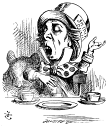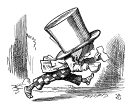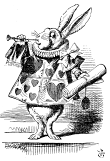Search us!
Search The Word Detective and our family of websites:
This is the easiest way to find a column on a particular word or phrase.
To search for a specific phrase, put it between quotation marks. (note: JavaScript must be turned on in your browser to view results.)
Ask a Question! Puzzled by Posh?
Confounded by Cattycorner?
Baffled by Balderdash?
Flummoxed by Flabbergast?
Perplexed by Pandemonium?
Nonplussed by... Nonplussed?
Annoyed by Alliteration?

Don't be shy!
Send in your question!
Columns from 1995 to 2006 are slowly being added to the above archives. For the moment, they can best be found by using the Search box at the top of this column.
 If you would like to be notified when each monthly update is posted here, sign up for our free email notification list.
If you would like to be notified when each monthly update is posted here, sign up for our free email notification list.
Trivia
All contents herein (except the illustrations, which are in the public domain) are Copyright © 1995-2020 Evan Morris & Kathy Wollard. Reproduction without written permission is prohibited, with the exception that teachers in public schools may duplicate and distribute the material here for classroom use.
Any typos found are yours to keep.
And remember, kids,
Semper Ubi Sub Ubi
|
To boldly hit “print.”
Dear Word Detective: Recently, I got to wondering about the word “font.” There are several definitions, including a baptismal “font,” a typeface and someone, like yourself, a “font” of wisdom. I can accept that there might be some similarity between a baptismal font (water being splashed about generously) and a “font of wisdom” (wisdom being splashed about generously), but how do typefaces fit into the picture? Even more obscure, perhaps, is the word “fontanelle.” My sources suggest it comes from a similar source as the other meanings of font — i.e., a little spring. Ew. — Jim Brown.
“Font of wisdom”? OK, that got the cats snickering. When I was a kid, my mother framed a cartoon from the New Yorker and put it on the wall of the home office she shared with my father (who started this column in 1954). It showed a woman laughingly addressing her husband, a stereotypical bearded wise man in robes, saying “I still can’t get over your being a sage. You didn’t know beans when I married you.” (Interestingly, if you Google “beans sage cartoon,” you’ll find that the New Yorker is selling prints of that cartoon.)
Explaining how a baptismal “font” could possibly be related to the sort of “font” you use on your computer turns out, thankfully, to be unnecessary. There are actually two separate and completely unrelated “fonts” in English.
The typeface kind of “font” is the easier to explain. We use “font” loosely to mean a style of type (e.g., Comic Sans, the official Microsoft font), but, more precisely, a “font” is a complete set of a certain style of type, i.e., including a complete alphabet, punctuation, numerals, etc. This “font” first appeared in English in the late 16th century, based on the French “fonte,” from “fondre,” meaning “to cast” as one “casts” objects from molten metal. The first use of “font” in English was, in fact, to mean simply “cast iron.” Type at that time was, of course, cast from metal, but it wasn’t until the late 17th century that “font” (then often in the form “fount” or even “found”) was used in the “family of type” sense (“Break down the Printing-Presses, melt the Founds.” 1723).
“Font” in the other senses you mention is from a different source, the Latin “fons,” meaning “spring” or “fountain.” (“Fons” is also the ultimate source of “fountain.”) The earliest use of “font” in Old English was to mean a receptacle for water in a church used for baptism, etc. The form “fount,” which had the same source but is sometimes considered a different word, popped up in literary use in the 16th century with the meaning “spring, source” in both literal and figurative senses (“Ancient founts of inspiration well thro’ all my fancy yet.” Tennyson, 1842). This is the elusive “fount” or “font” of wisdom. As to which is correct in this sense, both are; although the poetic use of “fount” has made “fount of wisdom” more popular, “font” seems to be gaining on it in recent years.
“Fontanelle” comes directly from French, where it means literally “little fountain.” The most common uses of “fontanelle” are for the depression or hollow between two muscles or the areas of a baby’s skull that remain soft and flexible for the first year or so after birth. (The human skull is actually made up of six separate bones that fuse together over time.) The use of “fontanelle” for these spots (and the space between muscles) comes from the slight depression at such places, similar to a spring in a shallow hollow of the earth.
What goes around comes around, half gone.
Dear Word Detective: How did the Lazy Susan get its name? — Hannah.
And why isn’t it called a Lazy Lyle, huh? After all, aren’t 99% of the world’s couch potatoes male? And (channeling Seinfeld here) what’s up with the men on HGTV’s House Hunters show? The women are all “I don’t want a pool because I’m worried about the kids” and “Those stairs are awfully steep for our toddler,” both valid good-parenting points. But the guys are just worried that they won’t have a “man cave” for playing video games and a special place to brew their own beer. It makes me wanna gently grab the guy by his precious spiky hair and ask, “What are you, twelve?”
OK, rant over. A “Lazy Susan” is a round, rotating platform or turntable, usually between one and three feet in diameter, used to serve food at a table or to store items, such as spices or condiments, in a cabinet or on a kitchen counter. At a dining table, a Lazy Susan allows guests to easily serve themselves, rather than having to ask their fellow chowhounds to pass the potatoes, etc.
One interesting thing about the term “Lazy Susan” (which also often appears uncapitalized) is the fact that the gizmo itself is much older than its name. Rotating trays, often with two or three tiers, became popular in the early 18th century, when they were known as “dumb waiters.” That term comes from the device performing, in some minor sense, the role of a waiter, but, being silent (“dumb”), not annoying diners with waiterly chatter. The term “dumb waiter” was also used, beginning in the 19th century, for small food-service elevators used between dining rooms and kitchens on lower floors in large houses or hotels. (I once lived in a house that had a dumb waiter, but our parents wouldn’t let us use it to transport cats, for which it would have been perfect.) This new use of “dumb waiter” for these elevators probably contributed to the adoption of a different term, “Lazy Susan,” for the rotating trays.
The earliest use of “Lazy Susan” as a term for a rotating serving tray found so far is in Good Housekeeping magazine in 1906 (“A ‘Lazy Susan’ from the days of the Massachusetts colony,” vol. 43, page 249). The origin of the term is a mystery, but there are two somewhat plausible theories. The first is that “Susan” was, at some point, considered a common name of female servants. Thus an inanimate device that took the place of a serving maid might be called a “Lazy Susan” because it served, but entirely in a passive or “lazy” sense. Unfortunately, by the beginning of the 20th century, when the term first appeared, household servants were far less common than they once had been, and thus were unlikely to inspire this sort of sardonic tribute. There’s also no evidence that “Susan” was considered a typical maid’s name.
A more intriguing possibility suggests that the “Susan” in “Lazy Susan” was inspired by the flower known as a “Black-eyed Susan” (Rudbeckia hirta, aka “Yellow Daisy”), whose circular blooms consist of yellow “rays” surrounding a dark brown center. The flower apparently took its name from the poem “Black-Eyed Susan” by English poet and dramatist John Gay (1685-1732), in which a sailor bids fond and extended adieu to his love Susan, who is called “black-eyed Susan” in the first stanza. The popularity of the Black-eyed Susan flower, and the resemblance of a circular serving tray to the circular bloom of the flower, may well have given us the “Lazy Susan.”
Please don’t play it again, Sam.
Dear Word Detective: I’ve been wondering why the noun and verb forms of “refrain” differ so much in meaning. In fact, the meanings of the noun and verb seem rather opposite, since the verb means “to avoid,” whereas the noun signifies something one sings (or states) over and over again. Could you please shed some light on this? — Tara McDaniel.
That’s a darn good question. In fact, it’s such a good question that I’m wondering why it never occurred to me to answer it before now. Maybe it actually did occur to me, perhaps while I was driving, and it just slipped my mind when I got home. Yeah, that’s the ticket. Kinda like last year’s taxes. Of course, explaining “refrain” is a lot easier than explaining why all these cats should be counted as a business expense, so that tax thing is just gonna have to wait.
My first hunch about the two meanings of “refrain” was that it was a case of an “autoantonym” or “contranym,” where one word can have two opposite (or nearly so) meanings. “Sanction,” for instance, can mean both “forbid” and “permit,” and “cleave” can mean either “stick to” or “split apart.” In some cases the two words are actually the same word (e.g., “sanction”), which has developed opposing meanings over time, but in others (e.g., “cleave”) the words have entirely separate origins and just happen to share that spelling.
Explaining how a single word like “sanction” developed two contradictory meanings can be a bit of a chore, because such transformations usually involve hundreds of years and several steps. So I’m relieved to report that in the case of “refrain,” what we’re dealing with is two separate, unconnected words whose senses are vaguely discordant, although not truly antonyms.
Oddly enough, both “refrains” first appeared in English in the 14th century. “Refrain” meaning “chorus of a song” or “a phrase frequently repeated in a poem or other writing” or “a statement, especially a complaint, that is frequently made” (“‘I’m bored’ is a frequent refrain coming from the back seat on long family car trips.”) comes directly from the Old French “refrain.” Follow “refrain” further back, and we eventually arrive at the Latin verb “refringere,” which meant “to break off.” That may seem strange for a word for things that, by definition, go on and on, but the key to a “refrain” is that it “breaks off,” i.e., stops, and then starts all over again. Although “refrain” did arrive in English in the 14th century, the word only became truly common in the 1800s.
The other “refrain” carries the basic sense of “curb, restrain, abstain or prevent.” English adopted the word from the Old French “refraigner,” meaning “to keep in check; control,” and the root of that French word certainly bears that out. “Refraigner” came from the Latin “refrenare,” meaning “to restrict with a bridle,” as one would a horse (“re,” back, plus “frenare,” to use a bridle). So “to refrain,” etymologically, means to literally “hold your horses.”
Interestingly, the verb “to refrain” originally had both intransitive (“refrain from drinking”) and transitive (“I would like to think that the nurses’ words refrained them.” 1952) uses. But the intransitive sense meaning “to abstain from doing something” is the only use commonly heard today.
|
Makes a great gift! Click cover for more.  
400+ pages of science questions answered and explained for kids -- and adults!
FROM ALTOIDS TO ZIMA, by Evan Morris
 
|



 can be found
can be found 




Recent Comments